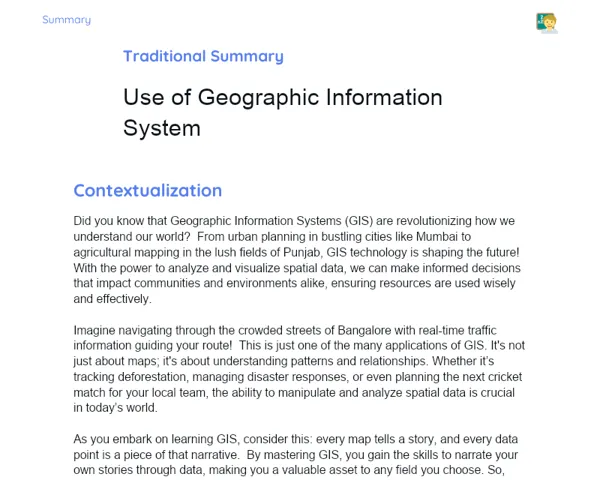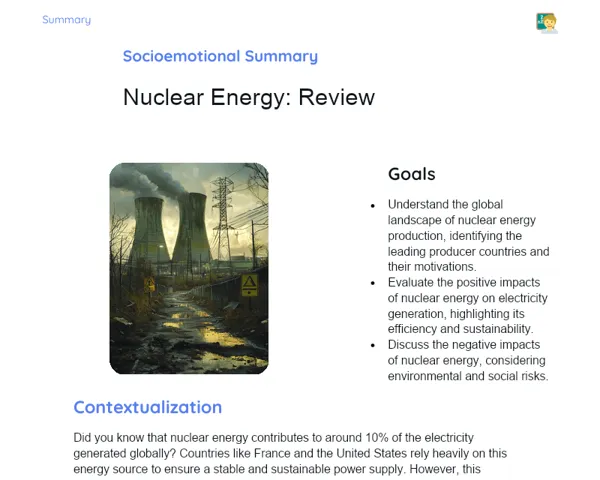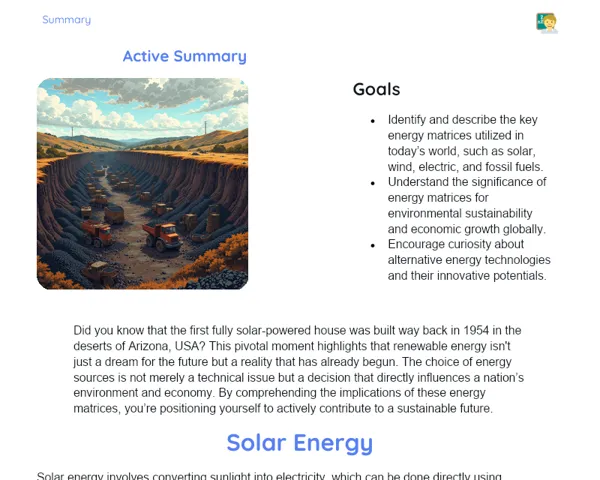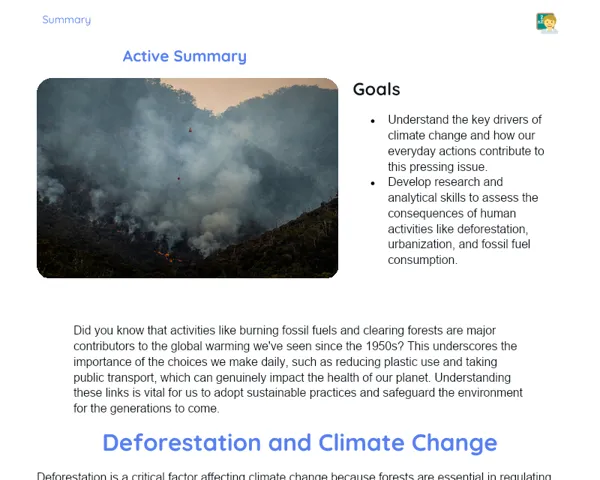Summary Tradisional | Geomorphology: Endogenous and Exogenous Agents: Review
Contextualization
The Earth's surface is continually evolving, influenced by internal forces called endogenic agents and external forces known as exogenic agents. Endogenic agents, which include volcanic activity and tectonic movements, emerge from within the Earth and are responsible for natural phenomena like earthquake occurrences and the formation of mountains and volcanoes. These processes are vital for shaping landforms and establishing the planet's geological framework, which in turn affects the layout of our landscapes.
Conversely, exogenic agents operate on the surface of the Earth, altering the terrain through processes like weathering, erosion, and sedimentation. Weathering leads to the breakdown of rocks, while erosion carries these sediments to different locations for deposition. These exogenic processes are significantly affected by climatic conditions and biological factors, playing a pivotal role in soil development and the ongoing reshaping of the Earth's surface. Grasping the interplay between endogenic and exogenic agents is fundamental to our understanding of physical geography, and is applicable in diverse areas such as agriculture, urban development, and disaster management.
To Remember!
Endogenic Agents
Endogenic agents are forces from within the Earth that greatly influence its surface. Key endogenic agents include tectonism, volcanism, and orogenesis. Tectonism refers to the movements of tectonic plates that form the Earth's crust. These movements can be divergent, convergent, or transform, leading to the creation of mountains, earthquakes, and geological faults. Volcanism entails the eruption of magma from the Earth’s interior to its surface, leading to volcanic landforms and islands. Orogenesis is the process of mountain building that usually occurs due to the collision of tectonic plates, which causes the crust to rise and form mountain ranges like the Himalayas and the Andes.
-
Tectonism: Movements of tectonic plates, including divergent, convergent, and transform boundaries.
-
Volcanism: Release of magma through volcanic eruptions, resulting in volcanoes and volcanic islands.
-
Orogenesis: Formation of mountains due to tectonic plate collisions.
Exogenic Agents
Exogenic agents are external forces that affect the Earth's surface, gradually eroding and reshaping the land. Key exogenic processes include weathering, erosion, and sedimentation. Weathering involves the breakdown of rocks in place without transporting the materials, which may occur through physical, chemical, or biological processes. Erosion refers to the action of external forces such as water, wind, and ice that wear away and transport rock and soil particles. Sedimentation is the process where these transported materials settle in new regions, forming various landforms like deltas and alluvial plains. These processes are influenced by climatic, biological, and human factors, making them integral to soil formation and the earth's ongoing topographical changes.
-
Weathering: Breakdown and decomposition of rocks, can be physical, chemical, or biological.
-
Erosion: Wearing away and transporting particles by natural forces like water, wind, and ice.
-
Sedimentation: Deposition of materials moved through erosion, forming features like deltas and alluvial plains.
Interaction between Endogenic and Exogenic Agents
The dynamics between endogenic and exogenic agents are crucial for understanding how landforms evolve. Endogenic processes establish primary features such as mountains and volcanoes, which are continuously reshaped by exogenic agents. For instance, a mountain formed through endogenic activity undergoes weathering and erosion over time, gradually being worn down. The sediments created from this process are transported by rivers and deposited in lower areas, giving rise to alluvial plains. This persistent interaction between internal and external forces guarantees a constantly changing Earth surface, resulting in diverse landscapes and geological settings.
-
Endogenic agents create initial features (mountains, volcanoes).
-
Exogenic agents continuously reshape these features (weathering, erosion, sedimentation).
-
Continuous interaction results in ever-changing landscapes.
Importance of Geomorphological Processes
Grasping geomorphological processes, whether endogenic or exogenic, is vital for numerous human-driven activities. In urban planning, for instance, understanding areas susceptible to earthquakes, mudslides, and volcanic activities can aid in constructing safer, more resilient buildings. In agriculture, knowing about weathering and erosion processes is essential for maintaining soil health and boosting productivity. Moreover, managing water resources and preparing for natural disasters are enhanced by studying these geomorphological processes, enabling us to take proactive measures and adapt to shifts in landforms and climate.
-
Urban planning: Identifying vulnerable areas for infrastructure development.
-
Agriculture: Ensuring soil health and improving crop yield.
-
Water resource management and disaster preparedness.
Key Terms
-
Geomorphology: Study of Earth's surface shapes and the processes that shape them.
-
Endogenic Agents: Internal forces like tectonism and volcanism that shape the planet.
-
Exogenic Agents: External forces such as weathering and erosion that modify the Earth's surface.
-
Tectonism: Movements of tectonic plates leading to mountain formation and earthquakes.
-
Volcanism: The eruption of magma from the Earth's core through volcanic activities.
-
Orogenesis: The mountain-forming process attributed to tectonic plate collisions.
-
Weathering: The breakdown and disintegration of rocks on the surface of the Earth.
-
Erosion: The process of wearing down and transporting rock and soil particles through natural agents.
-
Sedimentation: The accumulation of materials moved by erosive processes.
Important Conclusions
Understanding the geomorphological processes—both endogenic and exogenic—is foundational for grasping how the Earth's surface operates. Endogenic forces like tectonism, volcanism, and orogenesis contribute to the formation of mountains, volcanoes, and seismic events, establishing the foundational topography.
Exogenic forces such as weathering, erosion, and sedimentation act upon the surface, reshaping and wearing down landforms over time. Weathering breaks apart rocks, erosion carries sediments away, and sedimentation deposits materials in new locations. The ongoing synergy between endogenic and exogenic processes facilitates an ever-evolving surface.
Recognizing these processes is critical across various domains, including urban planning, agricultural practices, and water resource management. This understanding allows for effective preventive strategies and adaptations to changes brought about by environmental transformations, ensuring the safety and vitality of communities.
Study Tips
-
Review concepts of endogenic and exogenic agents through sketches and diagrams illustrating processes like mountain building, volcanic eruptions, weathering, erosion, and sedimentation.
-
Watch documentaries and educational videos focused on geological events to visualize discussed processes and appreciate their real-world applications.
-
Explore literature on geomorphology and physical geology to deepen your theoretical understanding and analyze case studies of geological changes in various global contexts.



